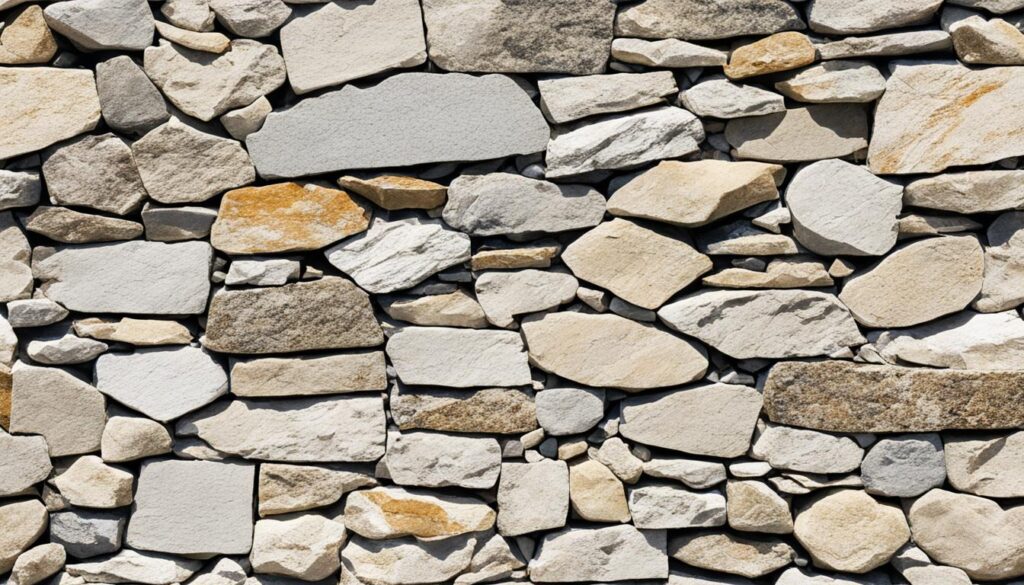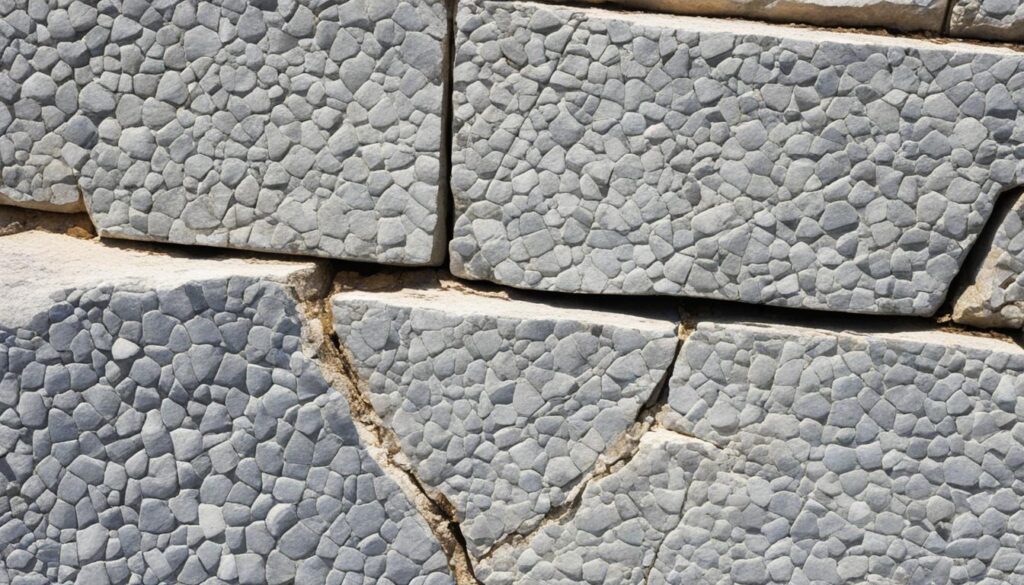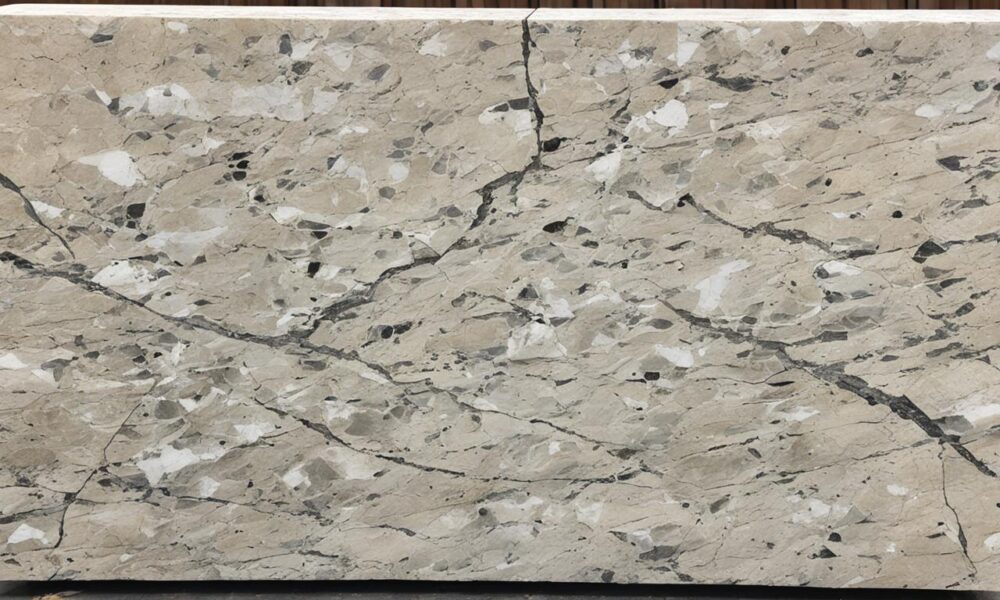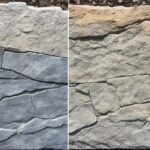Natural Stone Damage: Causes and Restoration Tips
Natural stone is a timeless choice for many homeowners. Yet, it faces damage over time. Factors like busy lifestyles, changing weather, and daily use can harm it. Damage can come from acidic substances, scratches, stains, and cracks.
Understanding these issues is key to keeping natural stone looking great. Proper restoration, repair, and maintenance are essential.
Experts use diamond grinding, honing, polishing, and sealing to fix stone. For minor repairs, DIY methods can work. But, using the wrong materials can cause more harm.
It’s important to clean stone properly and clean up spills quickly. Choosing a skilled stone repair service is crucial. Look for experience, the right approach, and quality craftsmanship for the best care.
Key Takeaways:
- Natural stone can be damaged by etching, scratches, stains, and cracks
- Experts use grinding, honing, polishing, and sealing for restoration
- DIY repairs work for small issues but can worsen damage with wrong methods
- Regular cleaning and quick spill cleanup keep stone surfaces in good shape
- Pick a trusted stone repair service by looking at their experience and quality
Understanding the Common Causes of Natural Stone Damage
Natural stone countertops and surfaces add beauty to any home. But, they need the right care to last long. Knowing what damages them helps homeowners keep their stone looking great for years.
Etching from Acidic Substances
Acidic liquids like citrus juices, vinegar, or wine can damage natural stone. They react with the stone’s calcium carbonate, causing dull spots or marks. These marks are more visible on polished surfaces.
To stop etching, clean spills right away and don’t put acidic items on the stone. Using a good sealer can also protect the stone. New treatments are being made to make stone more resistant to etching and damage.
Scratches and Abrasions
Scratches and abrasions are common on natural stone surfaces. These come from daily use, like cutting on the countertop or moving heavy things. Some stones, like granite, are tougher than others, such as marble and limestone.
To reduce scratches, use a cutting board and put felt pads under heavy items. Don’t use harsh cleaners or scrubbers. Regular care, like applying a sealer and cleaning right, helps keep scratches away.
Staining from Spills and Everyday Use
Natural stone can soak up liquids and oils, leading to stains. Things like wine, coffee, and oil can cause stains. The type of stone and how quickly you clean spills affect the stain’s severity.
To avoid stains, clean spills right away and don’t leave wet items on the stone. A sealer can make the stone less prone to staining. If a stain happens, there are ways to remove it, depending on the stone and stain type.
Cracks and Chips from Impact
Impact can cause cracks and chips in natural stone, especially in thinner slabs or unsupported areas. This damage can affect the stone’s look and strength if not fixed.
To prevent damage, be careful with heavy objects near stone surfaces. Make sure the stone is well-supported. If damage happens, professional services can fix it with techniques like epoxy injection or stone patching.
| Natural Stone | Common Damage | Prevention Tips |
|---|---|---|
| Marble | Etching, scratches, staining | Use coasters, placemats, and cutting boards; clean spills immediately; apply sealer regularly |
| Granite | Chips, cracks | Avoid impact from heavy objects; ensure proper installation and support |
| Limestone | Staining, scratches | Clean spills promptly; use felt pads under objects; apply sealer frequently |
| Travertine | Etching, staining | Wipe up acidic spills immediately; use coasters and placemats; seal regularly |
Understanding how to prevent natural stone damage helps homeowners enjoy their stone for years. Regular maintenance, quick cleaning, and using good sealers are key to keeping stone looking great.
Identifying Different Types of Natural Stone Damage
Keeping natural stone surfaces looking great is key. Spotting different types of damage is the first step. This helps homeowners and pros fix the stone quickly. We’ll look at the various damage types and how to spot them.

Recognizing Etching Marks
Etching marks are common on polished stones like marble and granite. They look like dull, hazy spots and come from acidic things like lemon juice or some cleaners. To spot them, check for dull spots that feel rough compared to the rest of the stone.
Spotting Cracks and Structural Issues
Cracks in stone can be minor or serious. It’s important to tell them apart. Minor cracks are just part of the stone’s look and don’t harm it. But serious cracks, caused by impact or bad installation, need quick action.
Did you know that water clear resin used for crack repair in natural stone takes approximately 24 hours to set?
Distinguishing Between Stains and Discoloration
Stains and discoloration can both affect natural stone. Stains are marks from substances like oil or wine getting into the stone. Discoloration happens when the stone’s color changes due to sunlight or chemicals. Spotting the difference helps you know what to fix first.
Each type of natural stone is different in how it handles damage. For example, granite is tough and resists stains well, but marble is softer and more prone to etching. Knowing what each stone is like helps you fix damage better. For more info on fixing natural stone, check out World of Stones USA.
| Stone Type | Common Damage | Identifying Characteristics |
|---|---|---|
| Marble | Etching, staining | Dull spots, discoloration |
| Granite | Cracks, chips | Deep lines, missing pieces |
| Limestone | Staining, erosion | Discoloration, rough patches |
| Slate | Flaking, splitting | Loose layers, uneven surface |
Knowing about the different damage types and how to spot them helps you fix issues fast and right. Early detection and the right fixes are key to keeping your natural stone looking great.
Professional Techniques for Restoring Damaged Natural Stone
Restoring damaged natural stone surfaces like granite, marble, limestone, and travertine requires professional skills. These methods fix specific problems and bring back the stone’s natural beauty. They also ensure the results last a long time.
Diamond Grinding for Scratch Removal
Diamond grinding is great for removing scratches and marks from natural stone. It uses special pads with diamond particles to smooth out the damaged area. Experts in stone restoration can do this safely and quickly, leaving the surface flawless.
Honing to Eliminate Etches and Stains
Etching and staining can happen to natural stone, especially in busy areas or when it’s exposed to acidic things. Honing is a way to fix these issues by making the surface smooth. It also helps reduce the look of deep stains, bringing back the stone’s original color and look.
Polishing to Restore Natural Sheen
Natural stone can lose its shine over time due to wear, cleaning residue, or wrong maintenance. Polishing is key to bringing back the stone’s natural sheen and highlighting its unique patterns and colors. This needs special equipment and skills to get a high-gloss finish without harming the stone.
A professional stone restoration company can check what your natural stone needs and suggest the best techniques to make it look beautiful and strong again.
Sealing for Long-Term Protection
After fixing your stone, it’s important to protect it from future damage. Sealing the stone creates a barrier that prevents stains, etching, and other damage. Experts use top-quality sealers made for each type of stone, giving the best protection without changing how the stone looks.
| Natural Stone | Common Damage | Restoration Technique |
|---|---|---|
| Granite | Scratches, stains, dulling | Diamond grinding, honing, polishing, sealing |
| Marble | Etching, scratches, stains | Honing, polishing, sealing |
| Limestone | Stains, etching, wear | Honing, polishing, sealing |
| Travertine | Holes, stains, scratches | Filling, honing, polishing, sealing |
Using these professional techniques and the skills of stone restoration experts can make your natural stone surfaces look beautiful and last long. This ensures they stay a beautiful part of your home or business for many years.
Common Natural Stone Damage and How to Restore It
Natural stone surfaces like countertops and flooring can get damaged over time. Common issues include stains from oil, rust, or water, and white spots from hit marks. Etching from acidic substances and cracks from thermal shock or poor installation are also common.

For natural stone repair, there are several methods to fix the surface. For minor scratches and stains, you might be able to fix them yourself with the right products and techniques. But for severe damage, you’ll need professional help for the best results.
Professional stone restoration includes several steps:
- Grinding to remove deep scratches and surface imperfections
- Honing to smooth out the surface and eliminate etches and stains
- Polishing to restore the natural sheen and color of the stone
- Sealing to protect the surface from future damage and staining
The methods used depend on the stone type and damage level. Marble, for example, is softer and more prone to etching and dulling. Travertine, limestone, and onyx also etch easily from acidic substances.
“Staining is a common issue on stone surfaces, especially marble, with various substances like drinks, foods, oils, or rust causing stains that are difficult to remove.”
Other issues include efflorescence, a white chalky substance from salt dissolution, and yellowing from age or oxidation. Spalling or flaking can happen when exposed to too much moisture. Poor installation can cause lippage, where tiles are set unevenly, and cracks from shifting sub-floors or bad jointing.
| Type of Damage | Causes | Restoration Methods |
|---|---|---|
| Stains | Oil, rust, water | Honing, polishing |
| Etching | Acidic substances | Honing, polishing |
| Scratches | Foot traffic, abrasive debris | Grinding, honing, polishing |
| Cracks | Thermal shock, poor installation | Epoxy injection, replacement |
| Yellowing | Age, oxidation, waxes | Honing, polishing |
When dealing with stone damage, check how bad it is and decide if you can fix it yourself or need professional help. Knowing the causes and how to fix them will help keep your natural stone looking great for a long time.
Choosing the Right Stone Restoration Service Provider
Choosing the right stone restoration companies is key when you need to fix your natural stone surfaces. You need experts with the right tools for the best results. Look at several factors to pick the best stone refinishers for your project.
First, find companies with a good history of fixing different stones like marble, granite, limestone, and travertine. Experts know how to meet your stone’s specific needs and use the best restoration methods.
Next, check the services offered by the companies you’re looking at. Full stone restoration can include:
- Deep cleaning and stain removal
- Honing and polishing to restore shine and smoothness
- Chip and crack repair
- Sealing to protect against future damage
A good stone restoration service will check your stone and suggest the best way to fix it for the look you want.
When looking at companies, ask for references and check their past work. This shows their quality and if they can deliver great results.
Last, think about the customer service and communication from the stone restoration pros you’re looking at. The best ones will listen to your needs, explain the process, and keep you updated. They should also back their work with a satisfaction guarantee.
| Factor | Importance |
|---|---|
| Experience | Ensures expertise in restoring various types of natural stone |
| Range of Services | Comprehensive restoration solutions for optimal results |
| Portfolio and References | Demonstrates quality of workmanship and customer satisfaction |
| Customer Service | Ensures clear communication and a smooth restoration process |
By looking at these factors, you can pick the right service to make your natural stone look new and last longer.
Maintaining Restored Natural Stone Surfaces
Keeping your natural stone surfaces looking great is key. Clean them regularly with pH-neutral products and soft cloths or mops. This stops dirt and grime from building up and keeps the stone shiny.
When cleaning marble, granite, or limestone, use cleaners made just for these stones. This prevents damage. Quickly cleaning up spills is also important to stop stains. This is especially true for stones like marble, onyx, and limestone.
To protect your stone from etching and scratches, use coasters under drinks and trivets for hot dishes. Don’t cut on the stone. Placing door mats at entrances and dust mopping often helps keep away abrasive debris that can harm the stone.
Sealing your stone every couple of years helps protect it from stains. Using penetrating/impregnating sealers gives long-lasting protection for both inside and outside. Stone enhancer sealers can also make the stone darker while still protecting it.
Getting professional help now and then is important for keeping your stone looking good. This might mean resealing, honing to remove scratches and stains, and polishing to bring back the shine. Don’t use cleaners that are too harsh or abrasive. Always follow the care tips for your stone type to make it last longer. With regular care, your natural stone will stay beautiful and strong in busy areas of your home or business.



